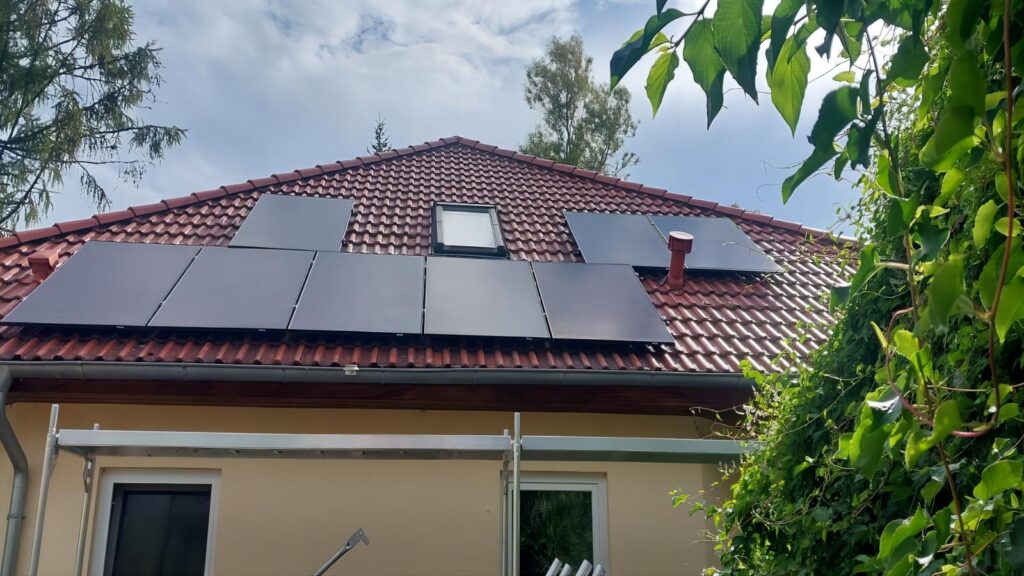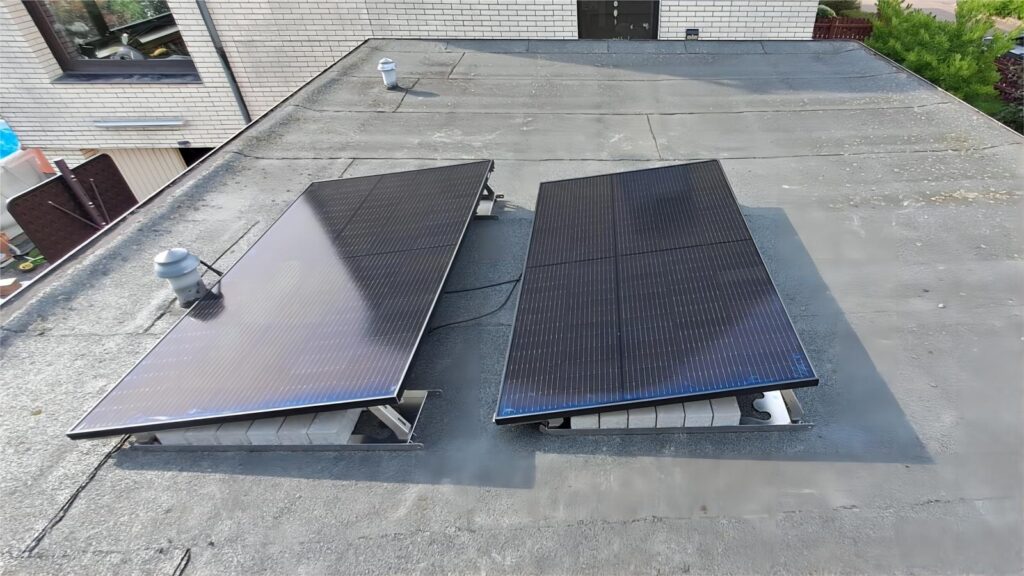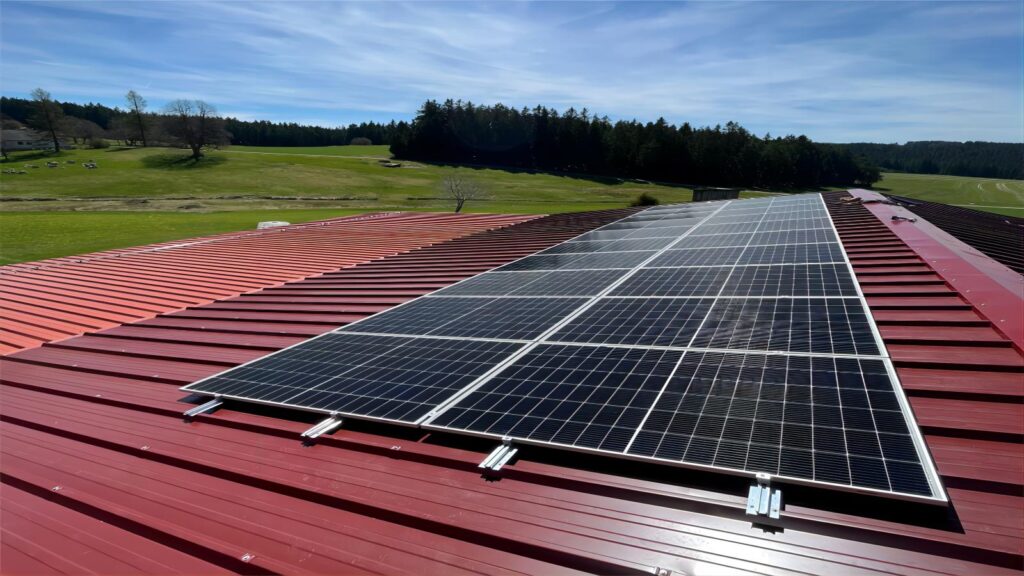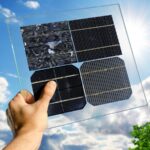What is a rooftop photovoltaic system?
a rooftop photovoltaic system is a type of photovoltaic system. It is made up of photovoltaic panels, mounting systems, cables, solar inverters, and other electrical accessories.
Rooftop photovoltaic system, whether they are linked to the grid or not, can be used with other ways to make electricity, like diesel generators, wind turbines, batteries, etc. These solar combination systems might be able to give you power all the time.
Features of rooftop photovoltaic system
- Rooftop solar systems have low pollution and great benefits for the environment. Rooftop distributed solar power generation project doesn’t make any noise and won’t pollute the air or water.
- Help power be made and used at the same time. Large ground power station power generation is boosted access to the transmission grid, only as a power station and run; and roof distributed photovoltaic power generation is boosted access to the distribution grid, power generation, coexistence of electricity, and the needs of local consumption as much as possible.
- There isn’t much power coming out. In general, a rooftop distributed solar power generation project has a capacity of a few kilowatts or less. Unlike centralized power plants, the size of a PV power plant doesn’t have much of an effect on how well it generates power and how well it makes money. A small PV system doesn’t have a smaller return on investment than a large one.
What are the requirements for putting a photovoltaic system on the roof?
- There are clear property rights for a separate roof or roof
- There is enough light on the roof: a power station is usually put on a south-facing roof to make sure there is enough light every day. Also, trees, poles, low walls, and other things in the way of the sun’s rays need to be taken into account before the station is put up.
- The roof has enough space: The roof space is a more obvious factor. A rough estimate for a 3 KW system is 22 to 35 square meters, a 4 KW system is 30 to 50 square meters, and a 5 KW system is 45 to 60 square meters.
- The roof has enough load-bearing capacity. The problem of roof load-bearing must be taken into account at the beginning of the planning process for a PV power plant.
How do you put a photovoltaic (PV) power plant on the roof?
There are three main categories of roofs: color steel tile roofs, masonry roofs, and flat-roofed concrete roofs. There is a big difference between these three types of roof designs. Even if the area is the same, the way photovoltaics are put in is different.
Slope roof installation
- Most photovoltaic panels are put in place above the slope. The photovoltaic array is laid out parallel to the roof, and the bracket uses steel embedded parts to hold the beams in a lattice.
- The vertical distance between the photovoltaic modules installed on the slope bracket and the roof meets installation, ventilation, and heat dissipation clearance requirements (the overhead distance is usually 150–200mm).
The link between the fixed points is made stronger by moving the connection point up. Bricks and tiles are a certain thickness, so they leave a certain amount of room between them. Before and after it is put together, it needs to be filled with sealer so that water doesn’t leak out.

Flat roof installation
- The structure of a flat roof can be chosen based on the roof’s finished surface, and the right bracket system can be chosen to go with it. In general, the support system is made up of columns, pillars, inclined beams, and beams. Fasteners connect the battery unit to the crossbeam. (0.35 to 0.50kN/m2)
- Angle of tilt during installation: As the mounting angle of the bracket, the angle that corresponds to the most power that can be made in the area in a year is used.
- Common types of house structures include a frame and floor slab made of cast-in-place concrete, a steel structure with a cast-in-place concrete floor slab, and a brick-concrete structure with a manufactured floor slab.

Color steel roof installation
Most of the time, color steel roofs are used in small companies or big industrial plants. The difference between how it is put together and how a sloped roof is put together is how the support is put together. The color steel roof is a plate of color steel with a clamp on it. The clamp is used to hold the plate in place. Its job is to put the fitting angle along the slope of the roof. If the roof’s structure can handle it, the angle of inclination can be raised to make the mounting angle bigger.

What should you watch out for when putting a photovoltaic system on a roof?
To make the most of the space, shade, waterproofing, load-bearing, and so on, the construction conditions of the roof should be set:
1.Looking at where the PV square array is on the roof:
Roof structure (fixed bracket to make sure the roof is waterproof); Purlin spacing, direction, and size distance; Component plan based on the roof structure; Fixing the bracket to make sure the roof is waterproof based on the roof structure.
2.Do a good job of waterproofing:
Before adding PV systems, make sure they won’t damage the roof. If a roof has a waterproof layer, it shouldn’t have any holes. If a colored steel roof has holes, it needs to be sealed with waterproof glue or a rubber mat.
3.Component length and width of placement:
During installation, the length and width of the components are based on the size of the roof. The long side of the component should be perpendicular to the bottom to save money on brackets. When fitting, set aside the width of the alignment slot.
Since 2008, Maysun has sold its goods in many different countries, and thousands of homes have them. Because Maysun has good relationships with area installers, you can be sure that they will help you put the best angle PV panels on your roof.
The project is somewhere in Belgium on a colored steel roof. The client loved it and made a video of it. ck on the button find out more.
With Maysun Solar, we have been We have a wide variety of stacked, half-cut and black frame, all black, silver frame solar panels to choose from, which have excellent performance and stylish design to blend in perfectly with any building.Maysun Solar has successfully established offices, warehouses, and long term relationships with excellent installers in many countries! We will install the most convenient solar panels for you and take care of your future cleaning and maintenance. Please feel free to contact us for an up-to-date quote on modules or any PV-related inquiries.

How to Effectively Clean and Intelligently Maintain Photovoltaic Systems for Optimal Performance?
Explore how scientific cleaning and intelligent maintenance can ensure the efficient operation of commercial and industrial photovoltaic systems. Practical advice covers module cleaning frequency, monitoring system configuration, and long-term strategies for energy savings and performance enhancement.

2025 European Photovoltaic Policy Map: Deployment Paths and Regional Strategies for Commercial and Industrial Photovoltaics
A comprehensive analysis of the 2025 European commercial and industrial photovoltaic policy map, focusing on deployment strategies, incentive comparisons, and zero-investment models to support businesses in achieving an efficient and green transition.

Empowering Factories with Solar Energy A Strategic Tool for Controlling Production Electricity Costs
Commercial and industrial solar is becoming a key solution for factories to reduce electricity costs and hedge against price fluctuations. This article systematically analyzes its deployment models, cost advantages, and sustainable value pathways.

How Businesses Can Offset Carbon Taxes with Solar Power
This article analyzes the latest carbon tax policies and photovoltaic deduction strategies, helping European businesses legally reduce taxes, increase profits through solar investment, and achieve a win-win situation for both economy and environment.

Forecast and Response: Seizing the Next Decade’s Growth Dividend in Europe’s Commercial and Industrial Photovoltaics Market
Maysun Solar analyzes the growth trends of commercial and industrial photovoltaics in Europe over the next ten years, from policies and ESG to technological innovation, helping companies seize the initiative in the energy transition.

How to Calculate Solar System ROI and Optimize Long-Term Returns?
Solar power is becoming a key solution for businesses to reduce costs and improve efficiency. Accurately calculating ROI and optimizing long-term returns are essential to maximizing investment value.



